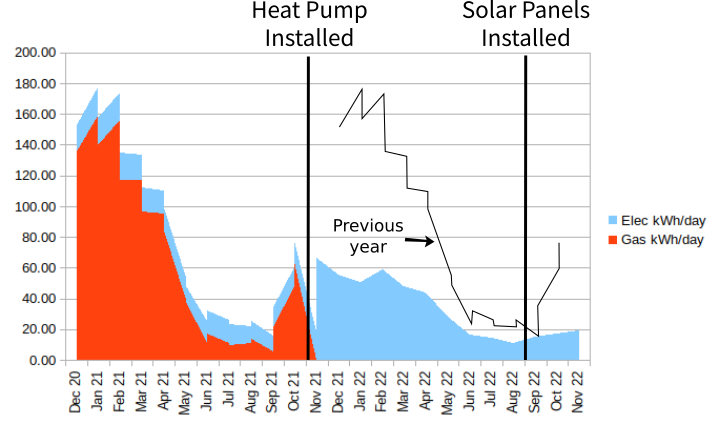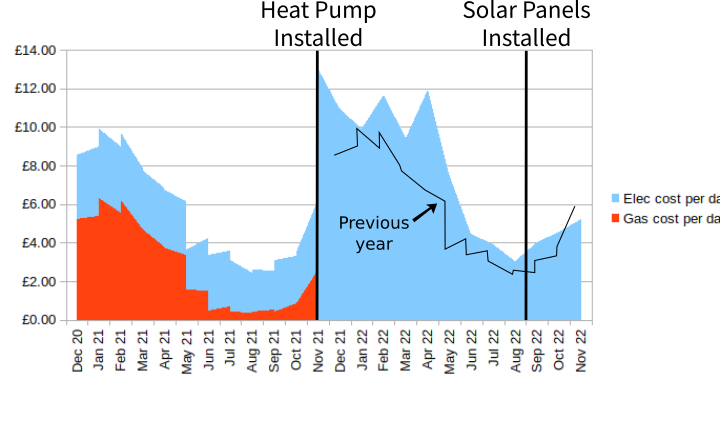10 months ago I wrote a blog post Air-Source Heat Pump – our experience so far, 2 months in about our new air source heat pump. Have a look back at that for photos of the device itself and more detail about installation etc.
Less energy
We used a lot less energy this year than last year. Here’s the graph for 2 years:

As you can see, we used a lot less energy in kWh this year than last year. Air source heat pumps work!
More money
Our energy cost more this year than last year. I’ve calculated this graph based on fixed prices, and I used 2021 prices to keep consistency with the last blog post, but the real-prices story is similar. Here is the graph for the last 2 years:

Why did our cost go up when our energy usage went down so dramatically?
Because electricity is too expensive!
Electricity is the right way to power our cars and homes, because it can be sourced sustainably, and in fact much of it really is being sourced sustainably right now.
Artificially-high electricity prices are preventing people switching to a better way.
Solar panels help!
In September this year we had solar panels installed. They look great and are working incredibly well. We were getting 10kWh per day from them in September. We don’t have a battery yet, but when it arrives we think we will be able to cover most of our summer energy costs using these panels.
Since the panels were installed, our reduced use of grid electricity meant that our energy costs for this year dropped below last year. Obviously it’s too soon to say for sure what the full impact is, but I can say we are very happy with our solar panels.
Our house is cozy
Our new heat pump heats our leaky house very well, and we are nice and cozy, even when temperatures outside drop below zero. The heat pump is less efficient when it’s cold outside, but still way better than a gas boiler.
Installed by Your Energy Your Way
[My wife used to be director of the company, so I declare an interest.]
Our heat pump, radiators and panels were installed by Your Energy Your Way and I can recommend them for good communication, service and quality.
 Air-Source Heat Pump – 1 year later
Air-Source Heat Pump – 1 year later
Key for cheap and comfortable heating with a heat pump is figuring out the right heating curve: the relation between the heating water temperature and the outside temperature.
Too low and comfort suffers, too high and efficiency drops needlessly. Every degree you can shave off will make it run ~2% cheaper for the same total heat output and comfort.
The optimal setting is house-specific so seldom correct after installation.
Your data seems to show a rather low sCOP of about 3 where for south England a result of 4 or 4.5 could be expected with radiators/underfloor heating. At -10°C you probably don’t need water hotter than 50°C, especially if you don’t let it cool down more than 1-2 degrees in night (again, look at the specs of the LG unit: efficiency drops under full load so keeping it warm is often more efficient than trying to heat back in the morning, though with poor insulation this is probably more nuanced).
The heating curve tuning is something that takes some time: adjust a little down, wait a week for results, repeat… so it is not something that can be expected from the installer but can sometimes save more than 30% of the heating bill. Once correct, it takes no maintenance.
Heat pump tuning can be a nice hobby for IT people: put a Pi with some thermometers and a modbus kWh meter next to the heatpump, log to a timeseries database and make sure the unit runs as long as possible with as low power as possible.
Also, adding some computer fans behind a radiator will double its heat output, allowing you to drop the heating temperature even further.